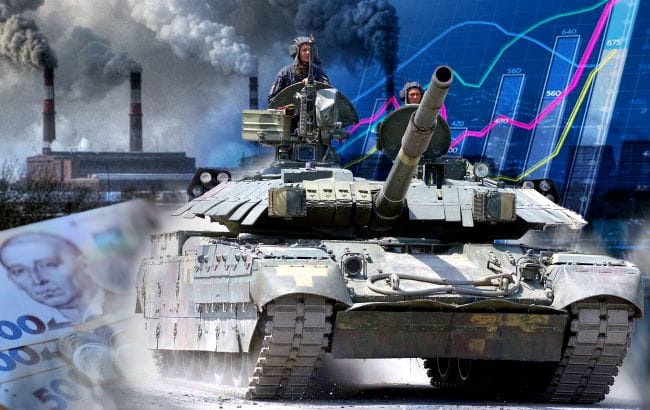How does the economy of Ukraine survive?
The economy of Ukraine amid war challenges

After the first year of a full-scale Russian invasion (February 2022), the economy of Ukraine faced the most dramatic fall in its history.
In the first months of the war, Ukraine faced an unprecedented challenge. The invasion heavily impacted the East and South, where industry and agriculture are concentrated.
Occupation, loss of facilities, the outflow of the labor force, and warfare brought the economy to the lowest point Ukraine has ever experienced.
According to government estimates, the national economy has fallen by about a third following the most challenging year in the country's recent history, and irreversible losses in industry have already exceeded 30 percent. Some sectors of the economy suffered much more. For example, the mining and metallurgical complex, which was lost as a result of the Russian occupation, the destruction of two large metallurgical plants in Mariupol, and the closure of seaports through which products were exported, ended 2022 with a 70 percent drop in both production and exports.
The Ukrainian economy had to adapt to the new reality and transform to survive. Business demonstrated unbelievable resilience and flexibility under extremely difficult conditions. Total direct losses of small and medium-sized businesses amounted to $83 billion.
After a successful counter-offensive operation that made Russia withdraw its forces from previously occupied Ukrainian territories, the business managed to renew its activity. Despite the ongoing warfare, farmers residing near the frontline in Ukraine persist in their agricultural activities. The resilience of these farmers is evident as they continue their work even amid the challenges posed by the war, which helps to keep the grain exports flowing and replenish the budget, trying to maintain Ukraine's status of being the bread basket for many countries depending on imports from Ukraine.
In addition to vital military aid, Ukraine has received crucial financial assistance from its Western partners. This financial support has played a significant role in enabling the Ukrainian government to meet its obligations, including the payment of salaries and pensions.. The assistance from Western allies has contributed to sustaining essential public services and supporting the well-being of Ukrainian citizens during these challenging times. In 2022, Ukraine received an unprecedented amount of financial assistance - 32 billion. Additionally, during the full-scale war, more than 40 Western countries provided military or financial aid to Ukraine.
According to various estimates, Ukraine's real GDP during 2023 grew by 5-5.5%. This recovery growth, after the sharp decline in 2022, happened despite ongoing warfare, attacks on the power grid, destruction of the civilian infrastructure, failure of the grain deal, and the need to find new ways to export.
During this year, Western support remained the key factor keeping the economy alive. The financial aid from the USA amounted to 20 billion dollars as micro-financial aid. Also, the EU gave 18 billion euros as a loan.
The aid package from the USA has become a lifeline for Ukraine.
By the end of 2023, debates in US politics created signals of a potential decrease in US financial aid and shook Ukrainian society and its leadership. The weakness of the economy jeopardized the Ukrainian resistance against Russia and caused the rollback of Ukrainian achievements in the war.
In April, after months of hesitation, Congress finally approved the allocation of a $61 billion aid package. The military aid not only addressed existing challenges on the battlefield but also mitigated potential threats, stabilizing the situation. The financial part of the package was a bailout for the country's economy. According to the Prime Minister of Ukraine, in 2024, Ukraine needed about $42 billion to close the budget deficit, which will make up about 21% of GDP. With the US aid package, the Government of Ukraine was able to meet its fundamental social obligations, including the payment of pensions and salaries to healthcare professionals and educators, as well as providing aid to those affected by the war.
The dependence of the Ukrainian economy on Western financial aid is evident.
Historic tax increase
In October 2024 Ukraine's Parliament approved a tax increase that is already called a "historic" due to its impact on business and population. The main change, which caused almost the greatest resonance, concerns the increase in the military levy.
The military levy, which used to be 1.5% of income, now rises to 5%. This supports all working citizens who receive wages. Thus, every Ukrainian who is officially employed will give a greater percentage of his income to support the defense forces of Ukraine to repel Russian aggression.
It might affect civilian`s ability to donate for the army's needs. Plenty of Ukrainians consistently donated some amount from their income to purchase drones, vehicles, and other equipment and such a way of supporting the army was quite effective. Now many Ukrainians will be less able to donate due to a higher percentage deducted from their income.
The new tax law has faced widespread criticism across society, fueling increased public dissatisfaction with the government. Many view the reform as unfair or poorly timed, deepening mistrust and sparking debates over its economic and social impact.
Ukraine stepped away from its economic partnership with Russia.
The Ukrainian economy has always depended on trade partnerships with Russia. After gaining independence in 1991, the Ukrainian economy remained focused on the Russian market; common past, joint construction and technological standards, and joint systems of electricity, railways, and pipelines contributed to this.
In 2014, after the Russian annexation of Crimea and the war in the Donbas region, marked the beginning of the breaking of business relations between Ukraine and Russia.
Despite the reduction in trade volumes, Russia still remained one of Ukraine's largest trade partners.
Since the beginning of the full-scale invasion in 2022, Ukraine officially terminated trade relations with Russia and introduced a full embargo on the import of goods. Before the full-scale invasion, despite mutual sanctions, Russia remained one of the largest trading partners.
In February 2022, imports from Russia to Ukraine amounted to 548 million dollars, and exports - 240 million dollars; then, in March of the same year, the indicators fell to 43 million dollars and 4.2 million dollars, respectively.
Today Ukraine successfully, as far as possible, under difficult circumstances, reoriented to trade partners worldwide, replacing imports from Russia and setting up complicated logistics.
Ukraine still continues to ensure the transit of Russian gas to Europe, which Russia pays for under international contracts. The fee for the transit of Russian gas is insignificant against the background of financial support provided to Ukraine by the West.
It is evident that the restoration of Russian-Ukrainian trade relations in the upcoming years is unlikely. Russia is unlikely to provide any reparations, and the prospect of re-establishing trade and economic ties between Russia and Ukraine seems bleak.

